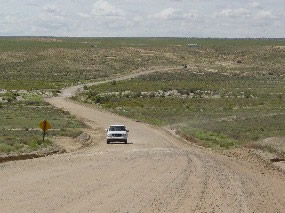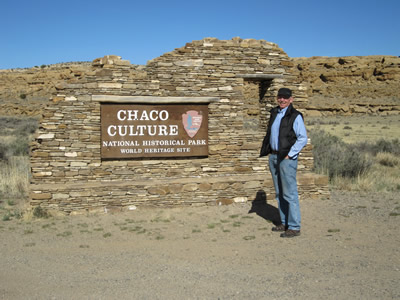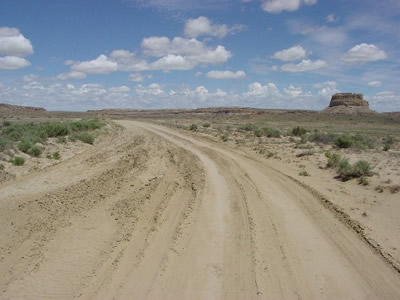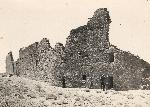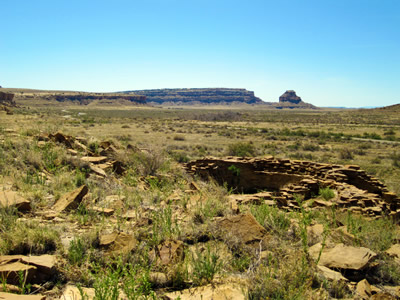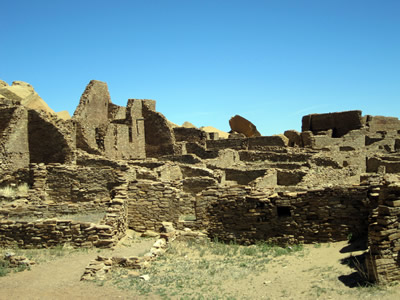
Red Rocks - Southwest trip, 2012
CHACO CANYON NATIONAL Historical PARK, New Mexico
Chaco Canyon This trip really began with our desire to finally see Canyon de Chelly and Chaco Canyon - two sites that everyone has heard of or seen on televions, but, as I discovered, only a few people have actually been there. And for good reasons. Chaco Canyon lies in the true wilds of northwest New Mexico, 65 miles from the nearest town with a motel and of those 65 miles, 30 are dirt roads that may or may not be passable for a normal car. Definitely not a good idea to take my Audi on that drive - it may have four wheel drive, but is not high enough to be good for the roads you see here. So, I looked for someone else to do the driving, preferably with a something like the truck on the picture on the right. That was not as easy as one might have thought. At first The only tours I could find for Chaco start in Flagstaff or Albuquerque and mean a week on the bus with thirty people. Not good. I was |
The dirt road we took to get into the park from the North |
||||
| getting rather discouraged but I finally found a web site for Salmon Ruins and its touring program. I can highly recommend it. Our guide, Nancy in the right picture, not |  |
only is a great driver of the Suburban ; she made sure we had plenty of water and food; but most importantly, she is a trained archeologists and really knows the area and the history of Chaco. We shared her with two ladies from British Columbia and spent a delightful and educational day. Unless one camps in the park, visiting Chaco will take a full day, remember the 65 mile drive just to get there and you still have to make it back. Below a picture of a lovely dirt road into Chaco from the south. Fajada Butte in the background on the right | |||
|
|
 |
|||
| A rare picture of the photographer - Nick at the entrance to Chaco | On the right ancient rock steps behind Chetro Ketl, providing a path to one of the outliers of Chaco - Pueblo Alto | ||||
| Chaco Canyon | |||||
| At Chaco Canyon the ancient pueblo people demonstrated a sophisticated understanding of astronomy. Spiral markings between rock clefts on top of Fajada Butte - picture on the right - made it possible to track sunlight with midday solar markings. At summer solstice one dagger of light descends through the center of the large spiral as is explained on the table pictured on the right. An interesting discussion of the astronomical markings on Fajada Butte can be found on the "Solstice Project" website |
Fajada Butte from the North |
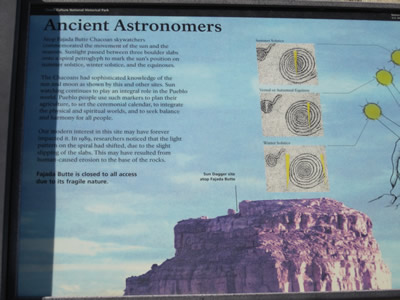
Pictures of spirals carved into the rock to track the sun |
|||
| Chaco Canyon is a quite large and it contained a significant number of Great Houses - buildings with up to four stories and a multitude of rooms - While no exact knowledge about their purpose exists, modern archeological research suggests that Chaco was not primarily used as a normal group of villages, instead many of the great houses were planned and used for ceremonial and/or administrative purposes. | |||||
|
An unexcavated mound with scattered fragments and the top of a building that peeks out of the dirt |
|
Today the tops of the ruins are reinforced with cement and masonry to prevent further deterioration. |
||
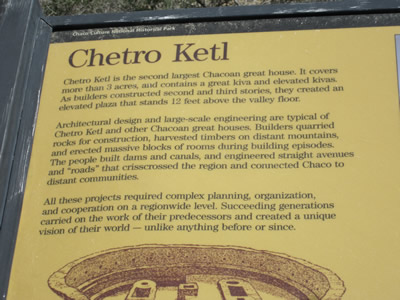 |
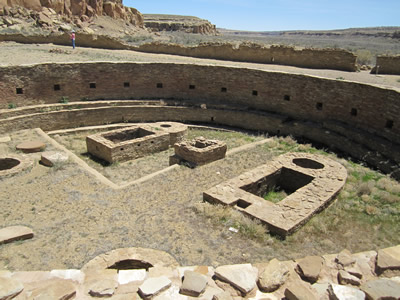 |
The great Kiva at Chetro Ketl. To provide a better understanding of the layout and construction of a Kiva, some reconstruction has taken place here. The various structures inside the Kiva have ceremonial purposes - the small one symbolizes the "Sipapu" the exit from the third (or fourth, depending on clan story) world before the ancestors of todays Puebloans entered the earth. | |||
|
A "borrowed" panoram of Chetro Ketl - - it gives a better idea of the size of some of the great houses than our puny little pictures |
|||||
| Cacao residue found in jar fragments at Pueblo Bonito provide more evidence that during the Chaco Culture heydays extensive trade occurred between Chaco and Central Mexico, since this is the nearest area where cacao beans could have been obtained. These discoveries also support the belief that the great houses were used for ceremonial purposes, since Chocolate drink was part of the ancient ceremonies. The residue found on these fragments are the result of a "re-dig" in 2009 of middens at Pueblo Bonito. Modern archeological and testing tecniques made it possible to discover evidence of past activities that could not have been found in the past. | |||||
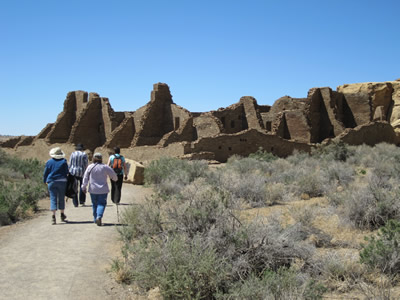 |
 |
 |
|||
Above left, the two ladies from BC, Nancy and I marching toward the ruins of Pueblo Bonito . Many of the great houses are built very close |
|||||
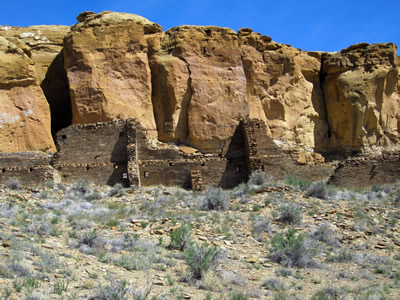 |
to rather fragile looking rock formations. And indeed, as the picture on the right shows, over time rock falls have destroyed some buildings at Pueblo Bonito. The damage on this picture was caused when "Threatening Rock" (good name!) collapsed in 1941 after an unusually heavy rainy season. Evidence shows that the builders understood the danger and built structural reinforcements to support the rock. Since it worked for 900 years, pretty good engineering! |  |
|||
| The pictures below show some interiors - the doors are carefully aligned and for some reason become smaller as one goes deeper into the interior. | |||||
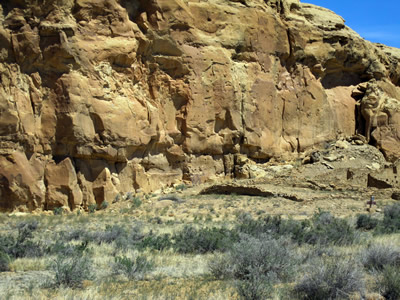 |
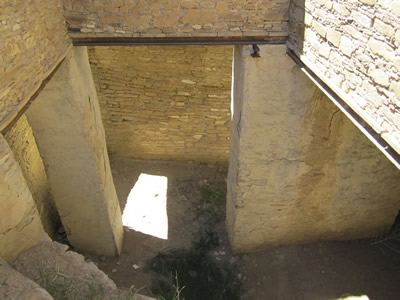 |
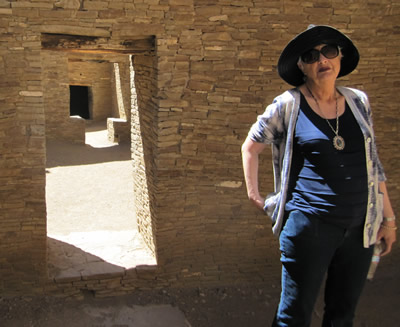 |
|||
| A lot of interesting information about the extensive archeological exploration of Chaco Canyon and the Chacoan culture can be found at the Chaco Research Archive website as well as on websites dedicated to individual Great Houses. | |||||
EditRegion4
